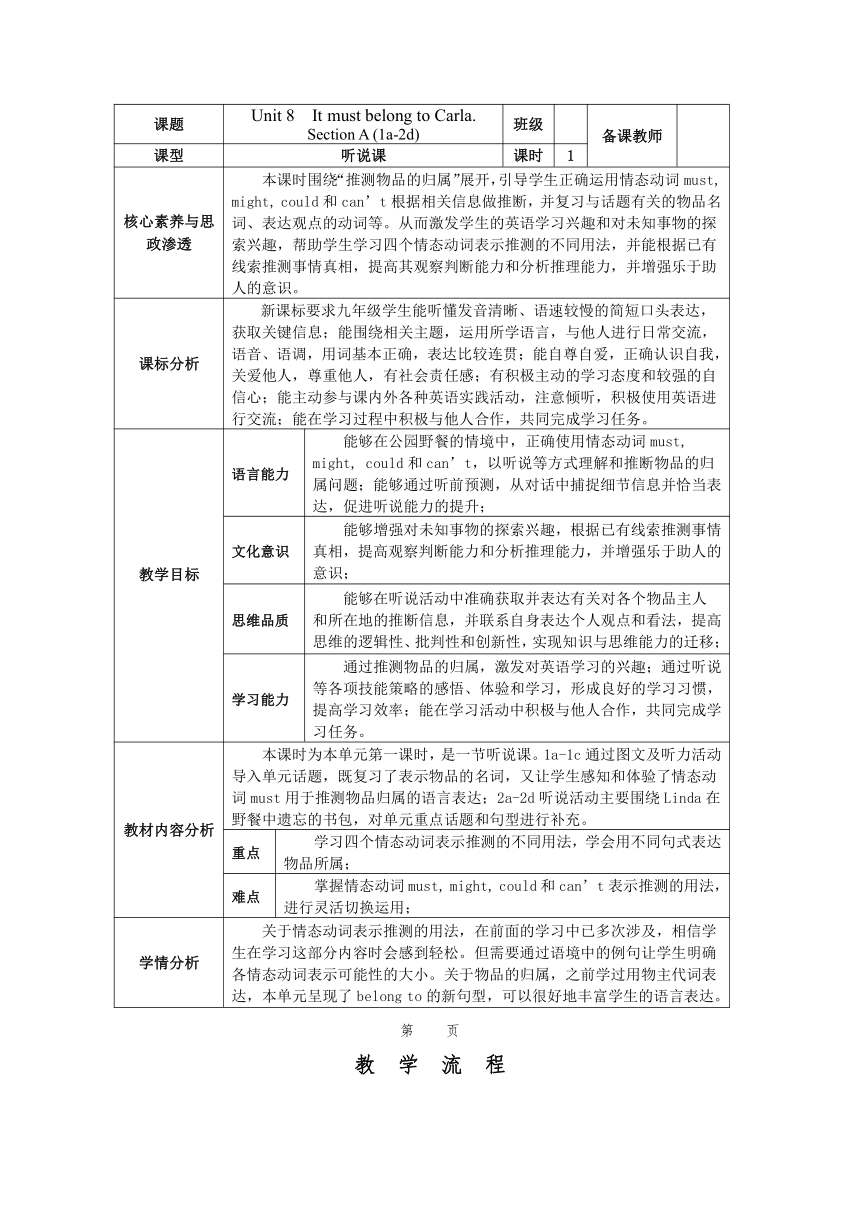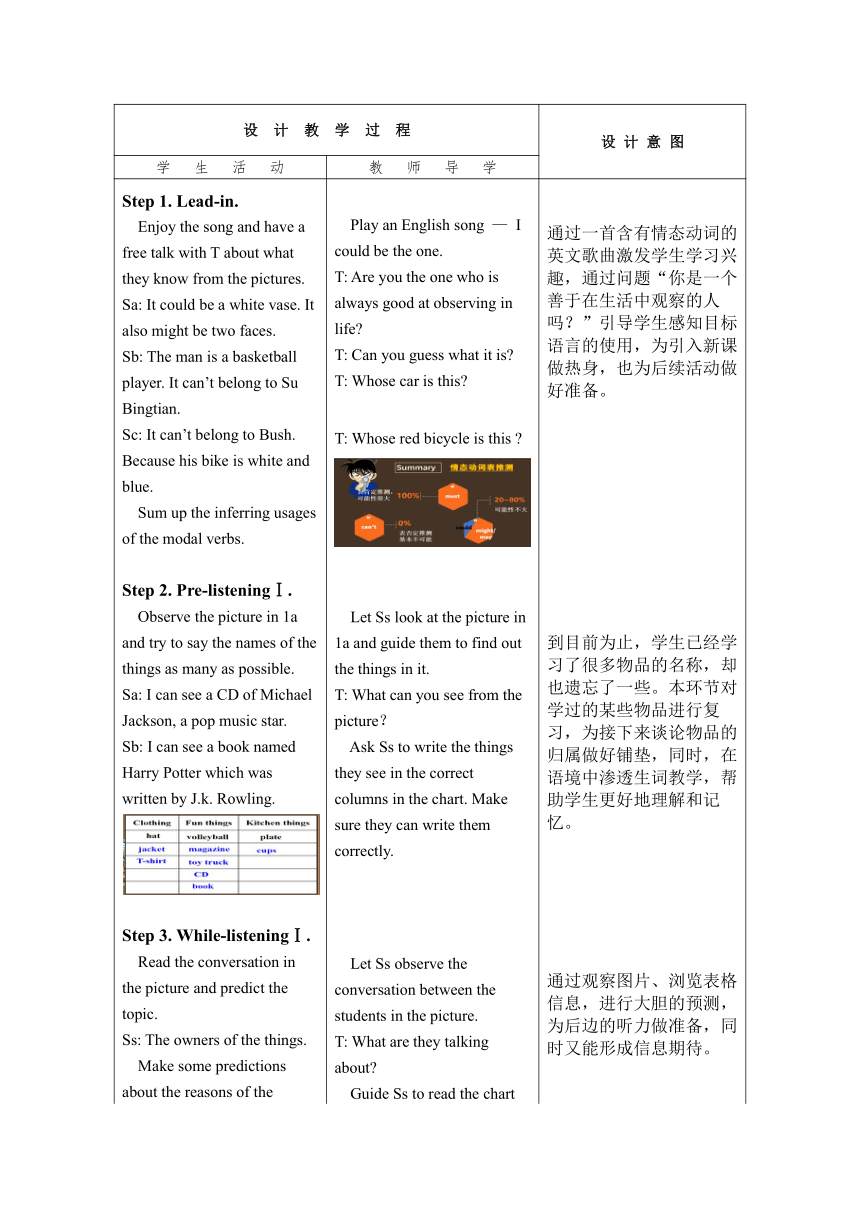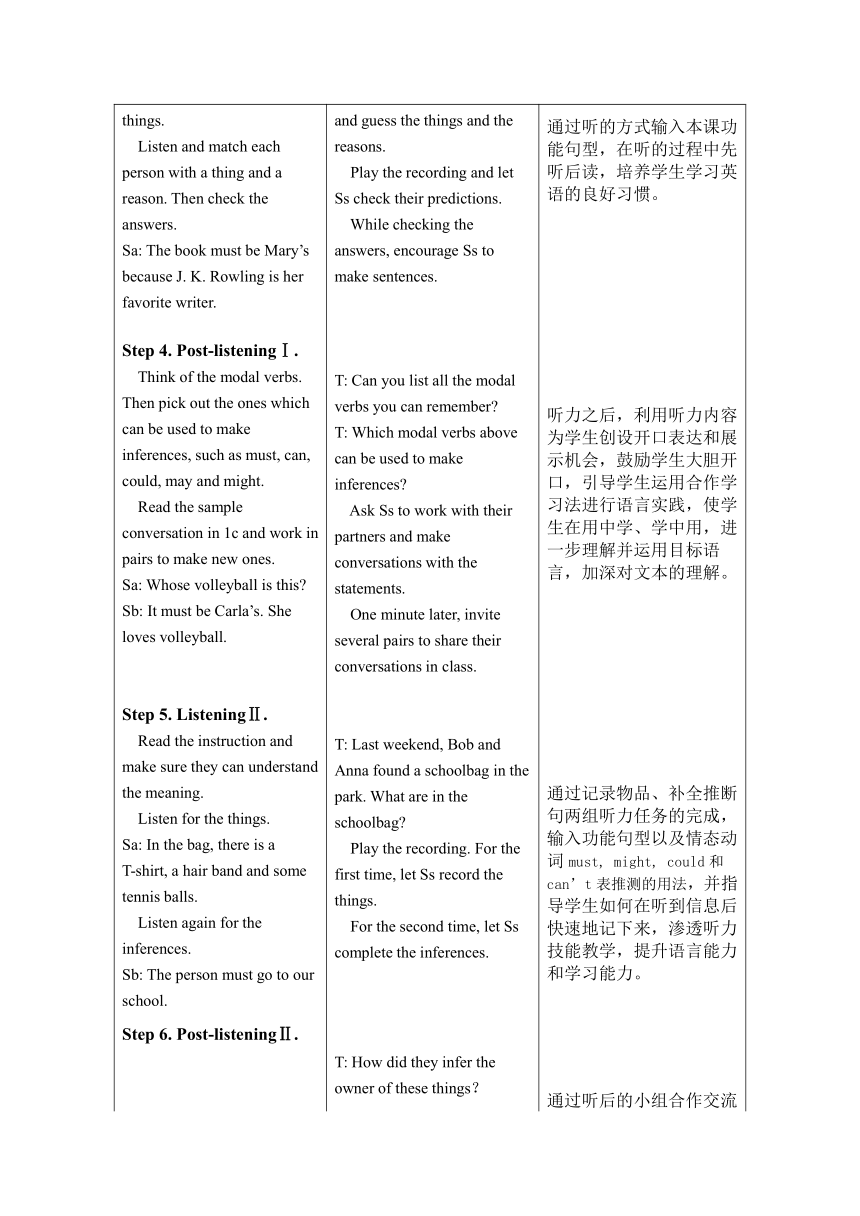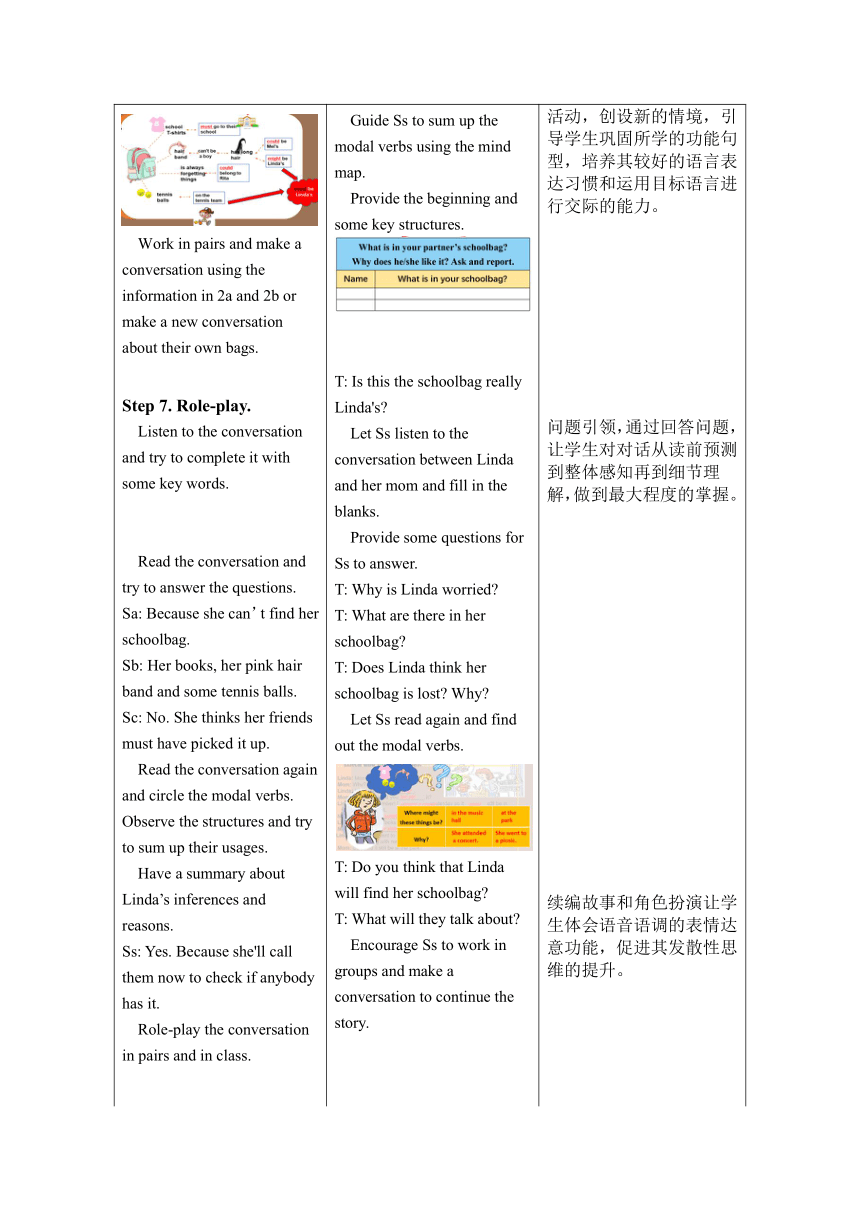人教版九年级全册Unit 8 It must belong to Carla Section A 1a-2d教学设计(表格式,含核心素养目标)
文档属性
| 名称 | 人教版九年级全册Unit 8 It must belong to Carla Section A 1a-2d教学设计(表格式,含核心素养目标) |  | |
| 格式 | docx | ||
| 文件大小 | 461.8KB | ||
| 资源类型 | 教案 | ||
| 版本资源 | 人教新目标(Go for it)版 | ||
| 科目 | 英语 | ||
| 更新时间 | 2024-09-24 11:10:06 | ||
图片预览




文档简介
课题 Unit 8 It must belong to Carla. Section A (1a-2d) 班级 备课教师
课型 听说课 课时 1
核心素养与思政渗透 本课时围绕“推测物品的归属”展开,引导学生正确运用情态动词must, might, could和can’t根据相关信息做推断,并复习与话题有关的物品名词、表达观点的动词等。从而激发学生的英语学习兴趣和对未知事物的探索兴趣,帮助学生学习四个情态动词表示推测的不同用法,并能根据已有线索推测事情真相,提高其观察判断能力和分析推理能力,并增强乐于助人的意识。
课标分析 新课标要求九年级学生能听懂发音清晰、语速较慢的简短口头表达,获取关键信息;能围绕相关主题,运用所学语言,与他人进行日常交流,语音、语调,用词基本正确,表达比较连贯;能自尊自爱,正确认识自我,关爱他人,尊重他人,有社会责任感;有积极主动的学习态度和较强的自信心;能主动参与课内外各种英语实践活动,注意倾听,积极使用英语进行交流;能在学习过程中积极与他人合作,共同完成学习任务。
教学目标 语言能力 能够在公园野餐的情境中,正确使用情态动词must, might, could和can’t,以听说等方式理解和推断物品的归属问题;能够通过听前预测,从对话中捕捉细节信息并恰当表达,促进听说能力的提升;
文化意识 能够增强对未知事物的探索兴趣,根据已有线索推测事情真相,提高观察判断能力和分析推理能力,并增强乐于助人的意识;
思维品质 能够在听说活动中准确获取并表达有关对各个物品主人和所在地的推断信息,并联系自身表达个人观点和看法,提高思维的逻辑性、批判性和创新性,实现知识与思维能力的迁移;
学习能力 通过推测物品的归属,激发对英语学习的兴趣;通过听说等各项技能策略的感悟、体验和学习,形成良好的学习习惯,提高学习效率;能在学习活动中积极与他人合作,共同完成学习任务。
教材内容分析 本课时为本单元第一课时,是一节听说课。1a-1c通过图文及听力活动导入单元话题,既复习了表示物品的名词,又让学生感知和体验了情态动词must用于推测物品归属的语言表达;2a-2d听说活动主要围绕Linda在野餐中遗忘的书包,对单元重点话题和句型进行补充。
重点 学习四个情态动词表示推测的不同用法,学会用不同句式表达物品所属;
难点 掌握情态动词must, might, could和can’t表示推测的用法,进行灵活切换运用;
学情分析 关于情态动词表示推测的用法,在前面的学习中已多次涉及,相信学生在学习这部分内容时会感到轻松。但需要通过语境中的例句让学生明确各情态动词表示可能性的大小。关于物品的归属,之前学过用物主代词表达,本单元呈现了belong to的新句型,可以很好地丰富学生的语言表达。
第 页
教 学 流 程
设 计 教 学 过 程 设 计 意 图
学 生 活 动 教 师 导 学
Step 1. Lead-in. Enjoy the song and have a free talk with T about what they know from the pictures. Sa: It could be a white vase. It also might be two faces. Sb: The man is a basketball player. It can’t belong to Su Bingtian. Sc: It can’t belong to Bush. Because his bike is white and blue. Sum up the inferring usages of the modal verbs. Step 2. Pre-listeningⅠ. Observe the picture in 1a and try to say the names of the things as many as possible. Sa: I can see a CD of Michael Jackson, a pop music star. Sb: I can see a book named Harry Potter which was written by J.k. Rowling. Step 3. While-listeningⅠ. Read the conversation in the picture and predict the topic. Ss: The owners of the things. Make some predictions about the reasons of the things. Listen and match each person with a thing and a reason. Then check the answers. Sa: The book must be Mary’s because J. K. Rowling is her favorite writer. Step 4. Post-listeningⅠ. Think of the modal verbs. Then pick out the ones which can be used to make inferences, such as must, can, could, may and might. Read the sample conversation in 1c and work in pairs to make new ones. Sa: Whose volleyball is this Sb: It must be Carla’s. She loves volleyball. Step 5. ListeningⅡ. Read the instruction and make sure they can understand the meaning. Listen for the things. Sa: In the bag, there is a T-shirt, a hair band and some tennis balls. Listen again for the inferences. Sb: The person must go to our school. Step 6. Post-listeningⅡ. Work in pairs and make a conversation using the information in 2a and 2b or make a new conversation about their own bags. Step 7. Role-play. Listen to the conversation and try to complete it with some key words. Read the conversation and try to answer the questions. Sa: Because she can’t find her schoolbag. Sb: Her books, her pink hair band and some tennis balls. Sc: No. She thinks her friends must have picked it up. Read the conversation again and circle the modal verbs. Observe the structures and try to sum up their usages. Have a summary about Linda’s inferences and reasons. Ss: Yes. Because she'll call them now to check if anybody has it. Role-play the conversation in pairs and in class. Step 8. Summary. Have a summary of the useful expressions, sentences and function. Play an English song — I could be the one. T: Are you the one who is always good at observing in life T: Can you guess what it is T: Whose car is this T: Whose red bicycle is this Let Ss look at the picture in 1a and guide them to find out the things in it. T: What can you see from the picture? Ask Ss to write the things they see in the correct columns in the chart. Make sure they can write them correctly. Let Ss observe the conversation between the students in the picture. T: What are they talking about Guide Ss to read the chart and guess the things and the reasons. Play the recording and let Ss check their predictions. While checking the answers, encourage Ss to make sentences. T: Can you list all the modal verbs you can remember T: Which modal verbs above can be used to make inferences Ask Ss to work with their partners and make conversations with the statements. One minute later, invite several pairs to share their conversations in class. T: Last weekend, Bob and Anna found a schoolbag in the park. What are in the schoolbag Play the recording. For the first time, let Ss record the things. For the second time, let Ss complete the inferences. T: How did they infer the owner of these things? Guide Ss to sum up the modal verbs using the mind map. Provide the beginning and some key structures. T: Is this the schoolbag really Linda's Let Ss listen to the conversation between Linda and her mom and fill in the blanks. Provide some questions for Ss to answer. T: Why is Linda worried T: What are there in her schoolbag T: Does Linda think her schoolbag is lost Why Let Ss read again and find out the modal verbs. T: Do you think that Linda will find her schoolbag T: What will they talk about Encourage Ss to work in groups and make a conversation to continue the story. Explain some language points. 通过一首含有情态动词的英文歌曲激发学生学习兴趣,通过问题“你是一个善于在生活中观察的人吗?”引导学生感知目标语言的使用,为引入新课做热身,也为后续活动做好准备。 到目前为止,学生已经学习了很多物品的名称,却也遗忘了一些。本环节对学过的某些物品进行复习,为接下来谈论物品的归属做好铺垫,同时,在语境中渗透生词教学,帮助学生更好地理解和记忆。 通过观察图片、浏览表格信息,进行大胆的预测,为后边的听力做准备,同时又能形成信息期待。 通过听的方式输入本课功能句型,在听的过程中先听后读,培养学生学习英语的良好习惯。 听力之后,利用听力内容为学生创设开口表达和展示机会,鼓励学生大胆开口,引导学生运用合作学习法进行语言实践,使学生在用中学、学中用,进一步理解并运用目标语言,加深对文本的理解。 通过记录物品、补全推断句两组听力任务的完成,输入功能句型以及情态动词must, might, could和can’t表推测的用法,并指导学生如何在听到信息后快速地记下来,渗透听力技能教学,提升语言能力和学习能力。 通过听后的小组合作交流活动,创设新的情境,引导学生巩固所学的功能句型,培养其较好的语言表达习惯和运用目标语言进行交际的能力。 问题引领,通过回答问题,让学生对对话从读前预测到整体感知再到细节理解,做到最大程度的掌握。 续编故事和角色扮演让学生体会语音语调的表情达意功能,促进其发散性思维的提升。
第 页
课 时 达 标 检 测
Ⅰ. 选择恰当的单词完成句子。 The watch must be (Mary/Mary's). She likes this kind of watch. I'm really (worried/worry) about my English test. When I arrived just now, there wasn't .(somebody/anybody). I'm sorry I (left/forgot) your dictionary at home. Alice, did you do (anything interesting/interesting anything) on the weekend Ⅱ. 补全对话,有两项为多余项。 (Three students are on the street.) A: There is a backpack on the ground. 6. B: Let's see what's in the backpack. C: Oh, there're earrings, notebooks, a T-shirt and a ping-pong bat. B: 7. C: Why do you think so B: Look at the earrings and the T-shirt with flowers. Boys can't wear them. C: 8. B: It might belong to Lucy. She likes playing ping-pong. A: 9. Many girls have ping-pong bats. B: Hey, don't guess. It must be Lucy's. Look! Her name is on one of the notebooks. A: OK. 10. B: All right. Let's go. C: She must be happy when she sees her backpack. A.You're right. B.Who does it belong to C.Let's give it back to her now. D.It can't be a boy's backpack. E.She might be running to catch a bus. F.You're welcome. G.I don't think so.
第 页
课 时 教 学 设 计 尾 页
板 书 设 计
Unit 8 It must belong to Carla. (Section A 1a-2d)
作 业 设 计
Level A Imagine you lost your favorite watch. Please make a conversation between you and your friend to recall where you went and what you did and make some inferences on where the watch might be. Try to use some modal verbs you’ve learned this lesson.
Level B Write a short class news report to tell the story titled “Who’s bag is it ” using the information in 2a, 2b and 2d.
教 学 反 思
第 页
课型 听说课 课时 1
核心素养与思政渗透 本课时围绕“推测物品的归属”展开,引导学生正确运用情态动词must, might, could和can’t根据相关信息做推断,并复习与话题有关的物品名词、表达观点的动词等。从而激发学生的英语学习兴趣和对未知事物的探索兴趣,帮助学生学习四个情态动词表示推测的不同用法,并能根据已有线索推测事情真相,提高其观察判断能力和分析推理能力,并增强乐于助人的意识。
课标分析 新课标要求九年级学生能听懂发音清晰、语速较慢的简短口头表达,获取关键信息;能围绕相关主题,运用所学语言,与他人进行日常交流,语音、语调,用词基本正确,表达比较连贯;能自尊自爱,正确认识自我,关爱他人,尊重他人,有社会责任感;有积极主动的学习态度和较强的自信心;能主动参与课内外各种英语实践活动,注意倾听,积极使用英语进行交流;能在学习过程中积极与他人合作,共同完成学习任务。
教学目标 语言能力 能够在公园野餐的情境中,正确使用情态动词must, might, could和can’t,以听说等方式理解和推断物品的归属问题;能够通过听前预测,从对话中捕捉细节信息并恰当表达,促进听说能力的提升;
文化意识 能够增强对未知事物的探索兴趣,根据已有线索推测事情真相,提高观察判断能力和分析推理能力,并增强乐于助人的意识;
思维品质 能够在听说活动中准确获取并表达有关对各个物品主人和所在地的推断信息,并联系自身表达个人观点和看法,提高思维的逻辑性、批判性和创新性,实现知识与思维能力的迁移;
学习能力 通过推测物品的归属,激发对英语学习的兴趣;通过听说等各项技能策略的感悟、体验和学习,形成良好的学习习惯,提高学习效率;能在学习活动中积极与他人合作,共同完成学习任务。
教材内容分析 本课时为本单元第一课时,是一节听说课。1a-1c通过图文及听力活动导入单元话题,既复习了表示物品的名词,又让学生感知和体验了情态动词must用于推测物品归属的语言表达;2a-2d听说活动主要围绕Linda在野餐中遗忘的书包,对单元重点话题和句型进行补充。
重点 学习四个情态动词表示推测的不同用法,学会用不同句式表达物品所属;
难点 掌握情态动词must, might, could和can’t表示推测的用法,进行灵活切换运用;
学情分析 关于情态动词表示推测的用法,在前面的学习中已多次涉及,相信学生在学习这部分内容时会感到轻松。但需要通过语境中的例句让学生明确各情态动词表示可能性的大小。关于物品的归属,之前学过用物主代词表达,本单元呈现了belong to的新句型,可以很好地丰富学生的语言表达。
第 页
教 学 流 程
设 计 教 学 过 程 设 计 意 图
学 生 活 动 教 师 导 学
Step 1. Lead-in. Enjoy the song and have a free talk with T about what they know from the pictures. Sa: It could be a white vase. It also might be two faces. Sb: The man is a basketball player. It can’t belong to Su Bingtian. Sc: It can’t belong to Bush. Because his bike is white and blue. Sum up the inferring usages of the modal verbs. Step 2. Pre-listeningⅠ. Observe the picture in 1a and try to say the names of the things as many as possible. Sa: I can see a CD of Michael Jackson, a pop music star. Sb: I can see a book named Harry Potter which was written by J.k. Rowling. Step 3. While-listeningⅠ. Read the conversation in the picture and predict the topic. Ss: The owners of the things. Make some predictions about the reasons of the things. Listen and match each person with a thing and a reason. Then check the answers. Sa: The book must be Mary’s because J. K. Rowling is her favorite writer. Step 4. Post-listeningⅠ. Think of the modal verbs. Then pick out the ones which can be used to make inferences, such as must, can, could, may and might. Read the sample conversation in 1c and work in pairs to make new ones. Sa: Whose volleyball is this Sb: It must be Carla’s. She loves volleyball. Step 5. ListeningⅡ. Read the instruction and make sure they can understand the meaning. Listen for the things. Sa: In the bag, there is a T-shirt, a hair band and some tennis balls. Listen again for the inferences. Sb: The person must go to our school. Step 6. Post-listeningⅡ. Work in pairs and make a conversation using the information in 2a and 2b or make a new conversation about their own bags. Step 7. Role-play. Listen to the conversation and try to complete it with some key words. Read the conversation and try to answer the questions. Sa: Because she can’t find her schoolbag. Sb: Her books, her pink hair band and some tennis balls. Sc: No. She thinks her friends must have picked it up. Read the conversation again and circle the modal verbs. Observe the structures and try to sum up their usages. Have a summary about Linda’s inferences and reasons. Ss: Yes. Because she'll call them now to check if anybody has it. Role-play the conversation in pairs and in class. Step 8. Summary. Have a summary of the useful expressions, sentences and function. Play an English song — I could be the one. T: Are you the one who is always good at observing in life T: Can you guess what it is T: Whose car is this T: Whose red bicycle is this Let Ss look at the picture in 1a and guide them to find out the things in it. T: What can you see from the picture? Ask Ss to write the things they see in the correct columns in the chart. Make sure they can write them correctly. Let Ss observe the conversation between the students in the picture. T: What are they talking about Guide Ss to read the chart and guess the things and the reasons. Play the recording and let Ss check their predictions. While checking the answers, encourage Ss to make sentences. T: Can you list all the modal verbs you can remember T: Which modal verbs above can be used to make inferences Ask Ss to work with their partners and make conversations with the statements. One minute later, invite several pairs to share their conversations in class. T: Last weekend, Bob and Anna found a schoolbag in the park. What are in the schoolbag Play the recording. For the first time, let Ss record the things. For the second time, let Ss complete the inferences. T: How did they infer the owner of these things? Guide Ss to sum up the modal verbs using the mind map. Provide the beginning and some key structures. T: Is this the schoolbag really Linda's Let Ss listen to the conversation between Linda and her mom and fill in the blanks. Provide some questions for Ss to answer. T: Why is Linda worried T: What are there in her schoolbag T: Does Linda think her schoolbag is lost Why Let Ss read again and find out the modal verbs. T: Do you think that Linda will find her schoolbag T: What will they talk about Encourage Ss to work in groups and make a conversation to continue the story. Explain some language points. 通过一首含有情态动词的英文歌曲激发学生学习兴趣,通过问题“你是一个善于在生活中观察的人吗?”引导学生感知目标语言的使用,为引入新课做热身,也为后续活动做好准备。 到目前为止,学生已经学习了很多物品的名称,却也遗忘了一些。本环节对学过的某些物品进行复习,为接下来谈论物品的归属做好铺垫,同时,在语境中渗透生词教学,帮助学生更好地理解和记忆。 通过观察图片、浏览表格信息,进行大胆的预测,为后边的听力做准备,同时又能形成信息期待。 通过听的方式输入本课功能句型,在听的过程中先听后读,培养学生学习英语的良好习惯。 听力之后,利用听力内容为学生创设开口表达和展示机会,鼓励学生大胆开口,引导学生运用合作学习法进行语言实践,使学生在用中学、学中用,进一步理解并运用目标语言,加深对文本的理解。 通过记录物品、补全推断句两组听力任务的完成,输入功能句型以及情态动词must, might, could和can’t表推测的用法,并指导学生如何在听到信息后快速地记下来,渗透听力技能教学,提升语言能力和学习能力。 通过听后的小组合作交流活动,创设新的情境,引导学生巩固所学的功能句型,培养其较好的语言表达习惯和运用目标语言进行交际的能力。 问题引领,通过回答问题,让学生对对话从读前预测到整体感知再到细节理解,做到最大程度的掌握。 续编故事和角色扮演让学生体会语音语调的表情达意功能,促进其发散性思维的提升。
第 页
课 时 达 标 检 测
Ⅰ. 选择恰当的单词完成句子。 The watch must be (Mary/Mary's). She likes this kind of watch. I'm really (worried/worry) about my English test. When I arrived just now, there wasn't .(somebody/anybody). I'm sorry I (left/forgot) your dictionary at home. Alice, did you do (anything interesting/interesting anything) on the weekend Ⅱ. 补全对话,有两项为多余项。 (Three students are on the street.) A: There is a backpack on the ground. 6. B: Let's see what's in the backpack. C: Oh, there're earrings, notebooks, a T-shirt and a ping-pong bat. B: 7. C: Why do you think so B: Look at the earrings and the T-shirt with flowers. Boys can't wear them. C: 8. B: It might belong to Lucy. She likes playing ping-pong. A: 9. Many girls have ping-pong bats. B: Hey, don't guess. It must be Lucy's. Look! Her name is on one of the notebooks. A: OK. 10. B: All right. Let's go. C: She must be happy when she sees her backpack. A.You're right. B.Who does it belong to C.Let's give it back to her now. D.It can't be a boy's backpack. E.She might be running to catch a bus. F.You're welcome. G.I don't think so.
第 页
课 时 教 学 设 计 尾 页
板 书 设 计
Unit 8 It must belong to Carla. (Section A 1a-2d)
作 业 设 计
Level A Imagine you lost your favorite watch. Please make a conversation between you and your friend to recall where you went and what you did and make some inferences on where the watch might be. Try to use some modal verbs you’ve learned this lesson.
Level B Write a short class news report to tell the story titled “Who’s bag is it ” using the information in 2a, 2b and 2d.
教 学 反 思
第 页
同课章节目录
- Unit 1 How can we become good learners.
- Section A
- Section B
- Unit 2 I think that mooncakes are delicious!
- Section A
- Section B
- Unit 3 Could you please tell me where the restroom
- Section A
- Section B
- Unit 4 I used to be afraid of the dark.
- Section A
- Section B
- Unit 5 What are the shirts made of?
- Section A
- Section B
- Review of Units 1-5
- Unit 6 When was it invented?
- Section A
- Section B
- Unit 7 Teenagers should be allowed to choose their
- Section A
- Section B
- Unit 8 It must belong to Carla.
- Section A
- Section B
- Unit 9 I like music that I can dance to.
- Section A
- Section B
- Unit 10 You're supposed to shake hands.
- Section A
- Section B
- Review of Units 6-10
- Unit 11 Sad movies make me cry.
- Section A
- Section B
- Unit 12 Life is full of the unexpected
- Section A
- Section B
- Unit 13 We're trying to save the earth!
- Section A
- Section B
- Unit 14 I remember meeting all of you in Grade 7.
- Section A
- Section B
- Review of Units 11-14
